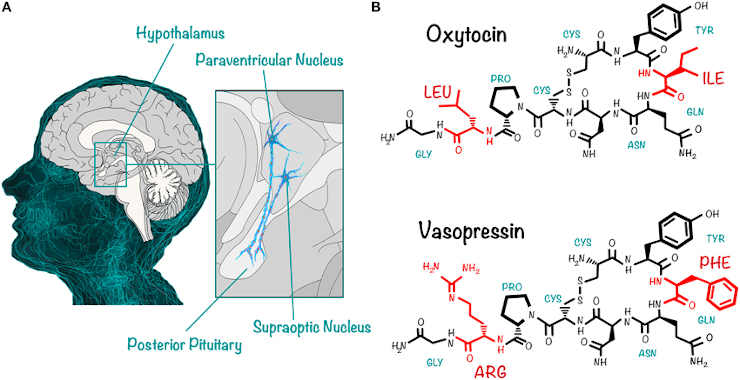Although evidence exists for the healing power of love, only recently has science turned its attention to providing a physiological explanation for love. The study of love in this context offers insight into many important topics, including the biological basis of interpersonal relationships and why and how disruptions in social bonds have such pervasive consequences for behavior and physiology.
Some of the answers will be found in our growing knowledge of the neurobiological and endocrinological mechanisms of social behavior and interpersonal engagement.
The Evolution Of Social Behavior
Nothing in biology makes sense except in the light of evolution. Theodosius Dobzhansky’s famous dictum also holds true for explaining the evolution of love.
Life on earth is fundamentally social: The ability to dynamically interact with other living organisms to support mutual homeostasis, growth, and reproduction evolved very early. Social interactions are present in primitive invertebrates and even among prokaryotes: Bacteria recognize and approach members of their own species.
Bacteria also reproduce more successfully in the presence of their own kind and are able to form communities with physical and chemical characteristics that go far beyond the capabilities of the individual cell (Ingham & Ben-Jacob, 2008).
As another example, various insect species have evolved particularly complex social systems, known as eusociality. Characterized by a division of labor, eusociality appears to have evolved independently at least 11 times in insects.
Research on honeybees indicates that a complex set of genes and their interactions regulate eusociality, and that these resulted from an “accelerated form of evolution” (Woodard et al., 2011). In other words, molecular mechanisms favoring high levels of sociality seem to be on an evolutionary fast track.
The evolutionary pathways that led from reptiles to mammals allowed the emergence of the unique anatomical systems and biochemical mechanisms that enable social engagement and selectively reciprocal sociality. Reptiles show minimal parental investment in offspring and form nonselective relationships between individuals.
Pet owners may become emotionally attached to their turtle or snake, but this relationship is not reciprocal. In contrast, most mammals show intense parental investment in offspring and form lasting bonds with their children.
Many mammalian species — including humans, wolves, and prairie voles — also develop long-lasting, reciprocal, and selective relationships between adults, with several features of what humans experience as “love.” In turn, these reciprocal interactions trigger dynamic feedback mechanisms that foster growth and health.
What Is love? An Evolutionary And Physiological Perspective
Human love is more complex than simple feedback mechanisms. Love may create its own reality.
The biology of love originates in the primitive parts of the brain — the emotional core of the human nervous system — which evolved long before the cerebral cortex. The brain “in love” is flooded with vague sensations, often transmitted by the vagus nerve, and creating much of what we experience as emotion.
The modern cortex struggles to interpret love’s primal messages, and weaves a narrative around incoming visceral experiences, potentially reacting to that narrative rather than to reality. It also is helpful to realize that mammalian social behavior is supported by biological components that were repurposed or co-opted over the course of mammalian evolution, eventually permitting lasting relationships between adults.
Is There A Hormone Of Love And Other Relationships?

Credit: Aspé-Sánchez M, Moreno M, Rivera M-I, Rossi A and Ewer J (2016) doi: 10.3389/fnins.2015.00510
One element that repeatedly appears in the biochemistry of love is the neuropeptide oxytocin. In large mammals, oxytocin adopts a central role in reproduction by helping to expel the big-brained baby from the uterus, ejecting milk and sealing a selective and lasting bond between mother and offspring (Keverne, 2006).
Mammalian offspring crucially depend on their mother’s milk for some time after birth. Human mothers also form a strong and lasting bond with their newborns immediately after birth, in a time period that is essential for the nourishment and survival of the baby.
However, women who give birth by cesarean section without going through labor, or who opt not to breastfeed, are still able to form a strong emotional bond with their children. Furthermore, fathers, grandparents, and adoptive parents also form lifelong attachments to children.
Preliminary evidence suggests that the simple presence of an infant can release oxytocin in adults as well (Feldman, 2012; Kenkel et al., 2012). The baby virtually forces us to love it.
The case for a major role for oxytocin in love is strong, but until recently was based largely on extrapolation from research on parental behavior (Feldman, 2012) or social behaviors in animals (Carter, 1998; Kenkel et al., 2012). However, recent human experiments have shown that intranasal delivery of oxytocin can facilitate social behaviors, including eye contact and social cognition (Meyer-Lindenberg, Domes, Kirsch, & Heinrichs, 2011) — behaviors that are at the heart of love.
Of course, oxytocin is not the molecular equivalent of love. Rather, it is just one important component of a complex neurochemical system that allows the body to adapt to highly emotional situations.
The systems necessary for reciprocal social interactions involve extensive neural networks through the brain and autonomic nervous system that are dynamic and constantly changing across the life span of an individual. We also now know that the properties of oxytocin are not predetermined or fixed.
Oxytocin’s cellular receptors are regulated by other hormones and epigenetic factors. These receptors change and adapt based on life experiences. Both oxytocin and the experience of love can change over time.
In spite of limitations, new knowledge of the properties of oxytocin has proven useful in explaining several enigmatic features of love.
Stress And Love
Emotional bonds can form during periods of extreme duress, especially when the survival of one individual depends on the presence and support of another. There also is evidence that oxytocin is released in response to acutely stressful experiences, perhaps serving as hormonal “insurance” against overwhelming stress.
Oxytocin may help to ensure that parents and others will engage with and care for infants; develop stable, loving relationships; and seek out and receive support from others in times of need.
Animal Models And The Biology Of Social Bonds
To dissect the anatomy and chemistry of love, scientists needed a biological equivalent of the Rosetta Stone. Just as the actual stone helped linguists decipher an archaic language by comparison to a known one, animal models are helping biologists draw parallels between ancient physiology and contemporary behaviors.
Studies of socially monogamous mammals that form long-lasting social bonds, such as prairie voles, have been especially helpful to an understanding the biology of human social behavior.
There Is More To Love Than Oxytocin
Research in prairie voles showed that, as in humans, oxytocin plays a major role in social interactions and parental behavior (Carter, 1998; Carter, Boone, Pournajafi-Nazarloo, & Bales, 2009; Kenkel et al., 2012). Of course, oxytocin does not act alone. Its release and actions depend on many other neurochemicals, including endogenous opioids and dopamine (Aragona & Wang, 2009).
Particularly important to social bonding are the interactions of oxytocin with a related neuropeptide known as vasopressin. The systems regulated by oxytocin and vasopressin are sometimes redundant.
Both peptides are implicated in behaviors that require social engagement by either males or females, such as huddling over an infant (Kenkel et al., 2012).
For example, it was necessary in voles to block both oxytocin and vasopressin receptors to induce a significant reduction in social engagement, either among adults or between adults and infants. Blocking only one of these two receptors did not eliminate social approach or contact.
However, antagonists for either the oxytocin or vasopressin receptor inhibited the selective sociality, which is essential for the expression of a social bond (Bales, Kim, Lewis-Reese, & Carter, 2004; Cho, DeVries, Williams, & Carter, 1999).
If we accept selective social bonds, parenting, and mate protection as proxies for love in humans, research in animals supports the hypothesis that oxytocin and vasopressin interact to allow the dynamic behavioral states and behaviors necessary for love.
Oxytocin and vasopressin have shared functions, but they are not identical in their actions. The specific behavioral roles of oxytocin and vasopressin are especially difficult to untangle because they are components of an integrated neural network with many points of intersection.
Moreover, the genes that regulate the production of oxytocin and vasopressin are located on the same chromosome, possibly allowing coordinated synthesis or release of these peptides. Both peptides can bind to and have antagonist or agonist effects on each other’s receptors.
Furthermore, the pathways necessary for reciprocal social behavior are constantly adapting: These peptides and the systems that they regulate are always in flux. In spite of these difficulties, some of the different functions of oxytocin and vasopressin have been identified.
Authors: Sue Carter and Stephen Porges, University of North Carolina, Northeastern University – Boston. Reublished via Creative Commons.
Last Updated on January 25, 2023
